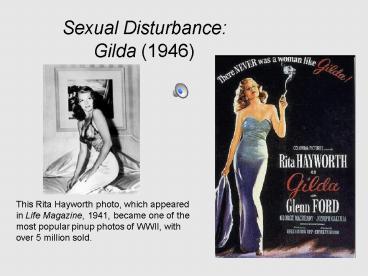Sexual Disturbance: Gilda 1946 PowerPoint PPT Presentation
1 / 11
Title: Sexual Disturbance: Gilda 1946
1
Sexual Disturbance Gilda (1946)
This Rita Hayworth photo, which appeared in Life
Magazine, 1941, became one of the most popular
pinup photos of WWII, with over 5 million sold.
2
Quiz 5
- Dyer, in "Resistance Through Charisma," points
out that in Gilda, Hayworth is not a typical noir
____________ character. - Besides Gilda, who else in the film is described
as "beautiful" or "pretty"? - Glenn Ford was aware that Gilda included
suggestions of ___________ between his character
and Ballin. - Martin points out that the producer of Gilda was,
somewhat unusually, ____________. - Martin also points out that many stories and a
number of scripts for certain films noirs were
written by ______________.
3
The Question(ing) of the Femme Fatale
- Gilda unusual portrayal of gender and sexual
relations. - Relatively open suggestions of male
homosexuality. - On the one hand portrayal of female sexuality
and desire that disturbs male order, control.
Typical of "femme fatale" portrayals of sexual
women as dangerous, as threat to men. - On the other hand Gilda in a number of ways
resists this typical representation of women's
sexuality desire as disturbing, etc.
4
The Question(ing) of the Femme Fatale
- Gilda brings a number of contradictions about
"women's representation" within film noir to the
surface. - In particular, although film noir has always
been--and probably still is--a male-dominated
phenomenon - One can find a resistance within stereotyped
portrayals of women as "bad," dangerous, or
sexualized--for in such portrayals, the women
usually have their own desires (and sexuality)
and do not simply defer to men.
5
Visual Pleasure, Again
- Worth thinking about Gilda (and film noir) in
terms of Mulvey's famous argument - Women's sexuality must be controlled either
through - (1) (sadistic) punishment by male protagonist or
(2) through making her the object of voyeuristic
male look (usually shared by both the male
protagonist and audience). - Certainly, can argue that both occur in Gilda.
- But in certain ways, Gilda also defies these
attempts at control.
6
You Can't Put the Blame on Mame?
- Film is narrated by Johnny supposedly "his"
story and point-of-view, as in many films noirs.
- Sadism Johnny certainly does attempt to
"punish" and control Gilda in rather sadistic
ways. - But how do we as audience perceive Johnny's view
of Gilda, his efforts to "punish" and control
her? - His efforts to to punish Gilda often seem overly
"sadistic" and perhaps "insane"--and make her
more sympathetic.
7
You Can't Put the Blame on Mame?
- Woman as To Be Looked At Audience is often
positioned to view Gilda through Johnny's gaze. - His look at her is linked to that of the largely
male audience who watches her in the "Put the
Blame on Mame" sequence--and to the audience
watching the movie. - Indeed, her exhibitionism (the fact that she is
seen by others) is what seems to disturb him the
most.
8
You Can't Put the Blame on Mame?
9
You Can't Put the Blame on Mame?
- No question that she (her sexuality) excites and
disturbs male audience/Johnny in this scene. - But here, female sexuality seems to exceed
attempts to "blame" and control it. - As the song's lyrics ironically imply putting
the blame on Mame (women) is problematic in
Gilda. - Woman is looked at, but is she simply
objectified? - Not just an object, as Dyer argues, because of
Hayworth's charisma, or because the film elicits
audience sympathy and identification with woman's
situation, as Martin suggests.
10
Why is Johnny so pretty?
- Curious that strong and strongly sexual female
characters often seem to occur in combination
with overtones of male homosexuality. - Gilda, Double Indemnity, Out of the Past, Laura,
Mildred Pierce? - In Gilda, Johnny is also given glamour shots,
called "very beautiful," is seen from Gilda's
perspective. - Johnny's relationship with Ballin parallels
Gilda's. - And then, the strange romantic triangles toast
to Johnny, Ballin, Ballin's other little friend
becomes toast to Johnny, Ballin, Gilda.
11
The Lady from Shanghai (1948)
- From one Rita Hayworth film noir to one made with
husband (at the time) Orson Welles. - Strange film, with almost incomprehensible plot.
Re-cut by studio. - Hayworth as true femme fatale.
- But, importantly, as title suggests, film
highlights a fascination with and simultaneous
fear of--that which is seen as other. - Sexual women as dangerous other but also other
cultures, races, the "exotic," etc.

